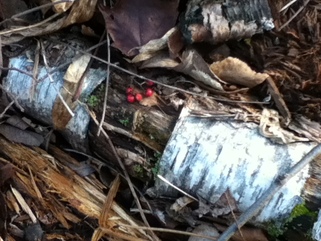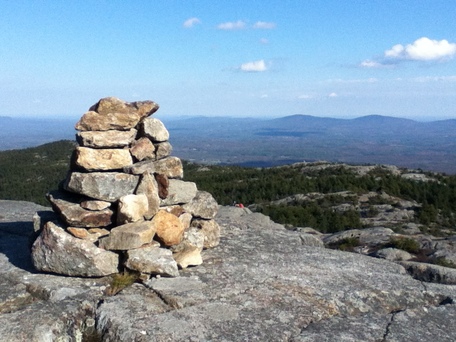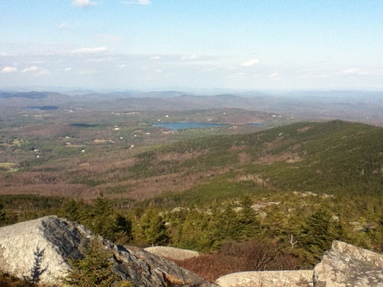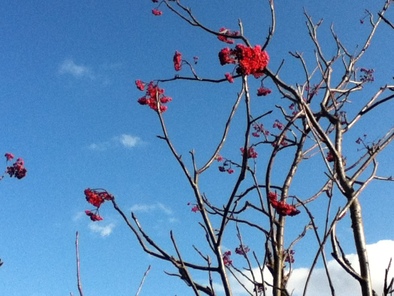
It’s one o’clock on Election Day in the USA. I’ve done my civic duty at the Dante Club in Somerville, Mass., and now I’m hiking the White Dot Trail with a splitting headache – an angry something’s been axing its way out of my skull since I clonked my dome on a doorway this morning while searching for the wristwatch I’ve worn for 15 years, and things only got worse as I ran around town car-gassing, ATMing and package-mailing. It was like being stuck in tar, but eventually I shook loose and now I’m free and moving in the chill air, happy, very happy, to be ascending my mountain again.
I breathe in, out, climb.
Behind me, at the trailhead, my car is one of 25 vehicles in the unpaved lot. It’s an uncrowded day on the third-most-climbed mountain in the world, cloudy in the 50s. I paid five bucks for admission and a map, and the ranger advised that darkness drops at 4:38 p.m. So far I’ve passed only a man shambling downhill in old sneakers and a hoodie. He grips a small bottle of water and wears no daypack. Just wandered by, went up on a whim. There’s always one of those guys.
I’ve gone up Mount Monadnock a couple dozen times. During my inaugural clamber as a freshman at Boston College – fall of 1978, a dorm field trip – I wore low-top canvas sneakers purchased at Herb’s Sports Shop in my hometown of West Hartford, Connecticut, and I sprained my ankle on the descent but said nothing, didn’t want to be the wuss. I carried a heavy crush for a young lady from New Jersey who I’d danced with the night before. The song we shared, I recall, was Start Me Up by the Rolling Stones, and such is the deceit of memory; Start Me Up and its raunchy lyrics didn't come out until the fall of 1981, my senior year. At that freshman “mixer” we probably bobbed to the flirtatious stylings of Olivia Newton-John or The Bee Gees.
Now I veer north on the Cascade Link Trail and hip-hop stone to stone across a mellow brook, my feet wrapped in waterproofed, air-cushioned Yakota Trail Merrill hiking boots, size 13. Color: walnut with yellow streaks. Made: in China, of course. Bought: at a chain-store shoe outlet, name forgotten. Loping along in my miracle boots, I notice the brook’s surface painted with autumn leaves floating on their backs, lazily spinning. Dark green rugs of moss encircle the bases of trees. I stop; it’s all quiet, or nearly so. I stand alone here just as the mountain stands alone in its environment. Monadnock means “lone mountain” or “island mountain” in the Abenaki Indian language, and indeed it exists without brothers, a rocky knuckle jutting from rolling forests. It looms in southern New Hampshire much like Mt. Kilimanjaro rises from the plains of Tanzania.
Perhaps I exaggerate. Perhaps not. For many New Englanders with but a spark of transcendental yearning, mighty Monadnock is our Kilimanjaro.
I breathe in, out, climb.
Behind me, at the trailhead, my car is one of 25 vehicles in the unpaved lot. It’s an uncrowded day on the third-most-climbed mountain in the world, cloudy in the 50s. I paid five bucks for admission and a map, and the ranger advised that darkness drops at 4:38 p.m. So far I’ve passed only a man shambling downhill in old sneakers and a hoodie. He grips a small bottle of water and wears no daypack. Just wandered by, went up on a whim. There’s always one of those guys.
I’ve gone up Mount Monadnock a couple dozen times. During my inaugural clamber as a freshman at Boston College – fall of 1978, a dorm field trip – I wore low-top canvas sneakers purchased at Herb’s Sports Shop in my hometown of West Hartford, Connecticut, and I sprained my ankle on the descent but said nothing, didn’t want to be the wuss. I carried a heavy crush for a young lady from New Jersey who I’d danced with the night before. The song we shared, I recall, was Start Me Up by the Rolling Stones, and such is the deceit of memory; Start Me Up and its raunchy lyrics didn't come out until the fall of 1981, my senior year. At that freshman “mixer” we probably bobbed to the flirtatious stylings of Olivia Newton-John or The Bee Gees.
Now I veer north on the Cascade Link Trail and hip-hop stone to stone across a mellow brook, my feet wrapped in waterproofed, air-cushioned Yakota Trail Merrill hiking boots, size 13. Color: walnut with yellow streaks. Made: in China, of course. Bought: at a chain-store shoe outlet, name forgotten. Loping along in my miracle boots, I notice the brook’s surface painted with autumn leaves floating on their backs, lazily spinning. Dark green rugs of moss encircle the bases of trees. I stop; it’s all quiet, or nearly so. I stand alone here just as the mountain stands alone in its environment. Monadnock means “lone mountain” or “island mountain” in the Abenaki Indian language, and indeed it exists without brothers, a rocky knuckle jutting from rolling forests. It looms in southern New Hampshire much like Mt. Kilimanjaro rises from the plains of Tanzania.
Perhaps I exaggerate. Perhaps not. For many New Englanders with but a spark of transcendental yearning, mighty Monadnock is our Kilimanjaro.

And then, birches. Around the corner dozens of skinny birches scatter up the slope, some alone, some in clumps of three or four. The leaves have come off surrounding oak and maple trees, so these birches really pop, shine white. It’s their glamour moment. After all, what’s better than ghost-white birches, trunks flecked with black splotches and stripes, reaching their gangly selves to heaven? These early-November birches go up, up, up. They’re making time before enveloping ice bends them astray, thwarts their ambition.
I rest my 54-year-old bones on a rock at the turnoff to the Red Spot Trail. Sunrays wheedle through cirrus clouds. I guzzle water, but the headache persists. Do I have a concussion? Wouldn’t be the first – banging into this low-flying world is a drawback of my 6’6’’ height. (Another is people informing me that I am, indeed, tall.) Why, I consider, was it so important to find that watch this morning? (It appeared a week later next to a stuffed giraffe in the attic.) A present from Kathleen, a former girlfriend, my watch is a sweep-hand model, retro and expensive, with a wristband of silver chain links. Kathleen picked it out at the now-defunct Filene’s Basement in Boston. She loved me and I loved her and, ultimately, I let her down. Sure, I had my reasons, but still. The watch is the only thing from that period – the years between the death of my first marriage and the day I met my beloved wife, Elahna – that I carry on my person. It keeps me, I hope, humble.
On this sunny rock I peel off my blue windbreaker and fleece, exposing a long-sleeve t-shirt. Beneath that, a regular tee. I’m layered like this forest world, its ragged garments a chaos of oranges, browns and blacks. Stray bird calls break through, clipped like afterthoughts. Bird blurts is more like it. Henry David Thoreau – who confined his Monadnock trips to spring and summer, camping beneath the boughs of red spruce trees – made his last ascension in August, 1860, two years before his death. On that hike he identified a bird that made “a dry, hard occasional chirp, more in harmony with the rocks.” Have I now heard his rock-harmony bird? Wrong time of year, sure, but things have changed a lot since then.
I rest my 54-year-old bones on a rock at the turnoff to the Red Spot Trail. Sunrays wheedle through cirrus clouds. I guzzle water, but the headache persists. Do I have a concussion? Wouldn’t be the first – banging into this low-flying world is a drawback of my 6’6’’ height. (Another is people informing me that I am, indeed, tall.) Why, I consider, was it so important to find that watch this morning? (It appeared a week later next to a stuffed giraffe in the attic.) A present from Kathleen, a former girlfriend, my watch is a sweep-hand model, retro and expensive, with a wristband of silver chain links. Kathleen picked it out at the now-defunct Filene’s Basement in Boston. She loved me and I loved her and, ultimately, I let her down. Sure, I had my reasons, but still. The watch is the only thing from that period – the years between the death of my first marriage and the day I met my beloved wife, Elahna – that I carry on my person. It keeps me, I hope, humble.
On this sunny rock I peel off my blue windbreaker and fleece, exposing a long-sleeve t-shirt. Beneath that, a regular tee. I’m layered like this forest world, its ragged garments a chaos of oranges, browns and blacks. Stray bird calls break through, clipped like afterthoughts. Bird blurts is more like it. Henry David Thoreau – who confined his Monadnock trips to spring and summer, camping beneath the boughs of red spruce trees – made his last ascension in August, 1860, two years before his death. On that hike he identified a bird that made “a dry, hard occasional chirp, more in harmony with the rocks.” Have I now heard his rock-harmony bird? Wrong time of year, sure, but things have changed a lot since then.

And I’m off. Here lie bigger boulders for bounding, and the occasional bursting-up tree root makes for a sturdy handhold. Soon I get the first good glimpse off the mountain: the reds and dusky oranges of trees in the valley. (Look at mountains, scolded Thoreau, not off them. “It is remarkable what haste the visitors make to get to the top” of Monadnock, he wrote, “…and then look away from it.”) I’m high enough to see two lakes, their silvery gray surfaces edged in black from the shadows of encircling trees. A little higher and I spy stray houses, the Bible Conference facility and a line of mountains to the east. My right knee twinges as I slide over a flat, angled rock; forgot my knee wrap – stupid! Mental note: always bring. Another twinge. Plus wrap for left ankle.
I meet a descending dad and college-aged daughter. They just had their first snowball fight of the year, volunteers Dad. My cell phone rings and I answer. It’s the social worker from the rehab facility where my 92-year-old mother is recovering from a collapsed lung. I stare toward Maine as we discuss the old bird’s frailty, her difficulties “toileting” herself and Medicare regulations. Maine doesn’t move. We agree that she’ll need more aides when she returns home, and we agree that she won’t like it. I imagine the social worker in an office cubicle or striding down a fluorescent-lit hallway. Where does she imagine me?
Brrr, getting cold. I put my fleece back on. This is a cold spot, heavily wooded. Ice burrows in ground divots, in pockets between boulders, and thick icicles spilling off the lip of a boulder remind me of a church organ. I pick an icicle and suck – tasteless. Red berries cluster on shrubs. When I squeeze one, orange goo plops out – a sherbety, pumpkin orange. Up ahead I find snowball snow squirreling under bushes, so I pack a good one and hurl it at a cairn – a mound of rocks marking the trail. Sigh, not even close. Then two women pass me on the way down, followed by a couple of teenybopper girls (why not in school?) and two dogs barking lazily, out of obligation. A minute later I converge upon the last of the brood, a teenage boy negotiating a rock face. Earbuds worm from his knit cap. Expression: peeved. “Almost there,” he tells me.
And he’s right. I surmount the slope and emerge above the tree line into a world of large, lichen-encrusted boulders stretching to the summit. The sight of the bare summit delivers a jolt – there it is, I’m gonna make it! Actually, this isn’t a natural tree line. Mount Monadnock used to be forested to the top, 3,165 feet above sea level, until farmers set a fire in 1800 to clear the lower slopes for pasture. You guessed it, the fire spread up the mountain. In the following years, bands of wolves took residence in the burnt, blown-down timber littering the slopes and preyed on local livestock. You guessed it again, the farmers set more fires to purge the wolves and those fires raged for weeks, forever stripping bare the mountain above 2,000 feet. Here I must add that this story is in dispute, but I prefer it to the one about soil erosion and glaciation.
I meet a descending dad and college-aged daughter. They just had their first snowball fight of the year, volunteers Dad. My cell phone rings and I answer. It’s the social worker from the rehab facility where my 92-year-old mother is recovering from a collapsed lung. I stare toward Maine as we discuss the old bird’s frailty, her difficulties “toileting” herself and Medicare regulations. Maine doesn’t move. We agree that she’ll need more aides when she returns home, and we agree that she won’t like it. I imagine the social worker in an office cubicle or striding down a fluorescent-lit hallway. Where does she imagine me?
Brrr, getting cold. I put my fleece back on. This is a cold spot, heavily wooded. Ice burrows in ground divots, in pockets between boulders, and thick icicles spilling off the lip of a boulder remind me of a church organ. I pick an icicle and suck – tasteless. Red berries cluster on shrubs. When I squeeze one, orange goo plops out – a sherbety, pumpkin orange. Up ahead I find snowball snow squirreling under bushes, so I pack a good one and hurl it at a cairn – a mound of rocks marking the trail. Sigh, not even close. Then two women pass me on the way down, followed by a couple of teenybopper girls (why not in school?) and two dogs barking lazily, out of obligation. A minute later I converge upon the last of the brood, a teenage boy negotiating a rock face. Earbuds worm from his knit cap. Expression: peeved. “Almost there,” he tells me.
And he’s right. I surmount the slope and emerge above the tree line into a world of large, lichen-encrusted boulders stretching to the summit. The sight of the bare summit delivers a jolt – there it is, I’m gonna make it! Actually, this isn’t a natural tree line. Mount Monadnock used to be forested to the top, 3,165 feet above sea level, until farmers set a fire in 1800 to clear the lower slopes for pasture. You guessed it, the fire spread up the mountain. In the following years, bands of wolves took residence in the burnt, blown-down timber littering the slopes and preyed on local livestock. You guessed it again, the farmers set more fires to purge the wolves and those fires raged for weeks, forever stripping bare the mountain above 2,000 feet. Here I must add that this story is in dispute, but I prefer it to the one about soil erosion and glaciation.

I pick up the pace and it’s a fun jaunt to the peak across slabs and terraces scratched by glaciers and inscribed with the initials of 19th century visitors toting hammers and cold chisels. Now these scars are redeemed by lichen, colorful as swipes of crayon. My headache is mostly gone, just a tipsy dizziness. At the summit I tap a circular bronze benchmark – a couple inches wide, set in stone by the United States Coastal and Geodesic Survey – with the tip of my hiking pole. On this ultimate place I revolve about, my lighthouse gaze shining on every New England state. The clouds have a bluish, grayish tinge and a dark mass comes in from the west, but it doesn’t look like rain cloud. The wind is swift up here, as if in triumph. It’s 2:40 p.m. and I’m alone on the peak – a first for this Monadnocker. Since I’m a boy, of course, I use the opportunity to pee off the mountainside. To the north, with the wind: a beautiful parabola.
Lunch: peanut butter and marmalade sandwiches, apple, golden Oreos. I put on gloves and change my Yale baseball cap for a winter hat. Then one last look around: although it isn’t clear enough to see the Prudential or Hancock towers – Boston monuments that appear on rare, pre-industrial days of visibility – the view still extends for 75 miles across a browning world splotched with lakes and rooftops. There are, to this eye, no people below, no farmers wielding torches or consumers driving to the mall. Nature’s cloak hides person, pet and wild animal, and I entertain the idea that this is the same view which Thoreau, for all his mountain love, must have taken in like a draught of fresh, high- altitude air. Save, of course, for the wisp of jet contrail. And that cell phone tower. And the new church steeple. And the plenitude of trees. In Thoreau’s day farmland and sheep meadow dominated the plains below. In our day the tropics are being torched, defiled, but here the forest has returned.
Lunch: peanut butter and marmalade sandwiches, apple, golden Oreos. I put on gloves and change my Yale baseball cap for a winter hat. Then one last look around: although it isn’t clear enough to see the Prudential or Hancock towers – Boston monuments that appear on rare, pre-industrial days of visibility – the view still extends for 75 miles across a browning world splotched with lakes and rooftops. There are, to this eye, no people below, no farmers wielding torches or consumers driving to the mall. Nature’s cloak hides person, pet and wild animal, and I entertain the idea that this is the same view which Thoreau, for all his mountain love, must have taken in like a draught of fresh, high- altitude air. Save, of course, for the wisp of jet contrail. And that cell phone tower. And the new church steeple. And the plenitude of trees. In Thoreau’s day farmland and sheep meadow dominated the plains below. In our day the tropics are being torched, defiled, but here the forest has returned.

The White Dot Trail, all the way down. I tell myself to avoid slipping on wet leaves, a sensible idea until I begin to daydream promiscuously and slip on wet leaves. On my butt, nothing radical. The ankle gimps again, ah well. At a stone-table outcropping I watch a squad of black birds – crows? – squawk and tumble into a faraway treetop. The sky is darkening and there’s something ominous, conspiratorial, in this noisy gathering. Something telling me to get home already. No more larking about. So I pick up the pace, watch my feet land. Safety first. Eyes glued to the trail, I could have missed Sasquatch tiptoeing by.
Near the bottom, light failing, I catch up with a portly guy with excellent gear. On his back rides a red Osprey pack that looks like the one I schlepped across Israel. It sports a sippy tube curling from backpack reservoir to mouth. I tell him that with that kind of constant access to water I forego stopping and exhaust myself. He says that without the tube he forgets to drink and becomes dehydrated. A resident of the nearby town of Ridge, my new friend is only hiking to the spring and back today. A quick, after-work jaunt. A Monadnock appetizer. Sometimes on weekends he takes his wife and kids to the peak, and I imagine his backpack stuffed with first-aid kit, lunches, bungee cords and stuffed animals. He’s gone up in winter, too, and recommends MICROspikes for boots. I admire the nifty headlamp strapped to his forehead. It illuminates up to 70 feet, he says, and later I order both items online.
In the parking lot, we wish each other well. Then I call my mom, who’s tired after physical therapy, and my wife, who’s done with patients for the day. I change into sneakers and drive home in darkness. My body aches nicely. My head is clear. The radio news is panting, breathless on Election Day, and soon enough I’ll learn that almost every candidate and ballot initiative I voted for this morning has lost. But it was a good day on Monadnock.
Near the bottom, light failing, I catch up with a portly guy with excellent gear. On his back rides a red Osprey pack that looks like the one I schlepped across Israel. It sports a sippy tube curling from backpack reservoir to mouth. I tell him that with that kind of constant access to water I forego stopping and exhaust myself. He says that without the tube he forgets to drink and becomes dehydrated. A resident of the nearby town of Ridge, my new friend is only hiking to the spring and back today. A quick, after-work jaunt. A Monadnock appetizer. Sometimes on weekends he takes his wife and kids to the peak, and I imagine his backpack stuffed with first-aid kit, lunches, bungee cords and stuffed animals. He’s gone up in winter, too, and recommends MICROspikes for boots. I admire the nifty headlamp strapped to his forehead. It illuminates up to 70 feet, he says, and later I order both items online.
In the parking lot, we wish each other well. Then I call my mom, who’s tired after physical therapy, and my wife, who’s done with patients for the day. I change into sneakers and drive home in darkness. My body aches nicely. My head is clear. The radio news is panting, breathless on Election Day, and soon enough I’ll learn that almost every candidate and ballot initiative I voted for this morning has lost. But it was a good day on Monadnock.
 RSS Feed
RSS Feed